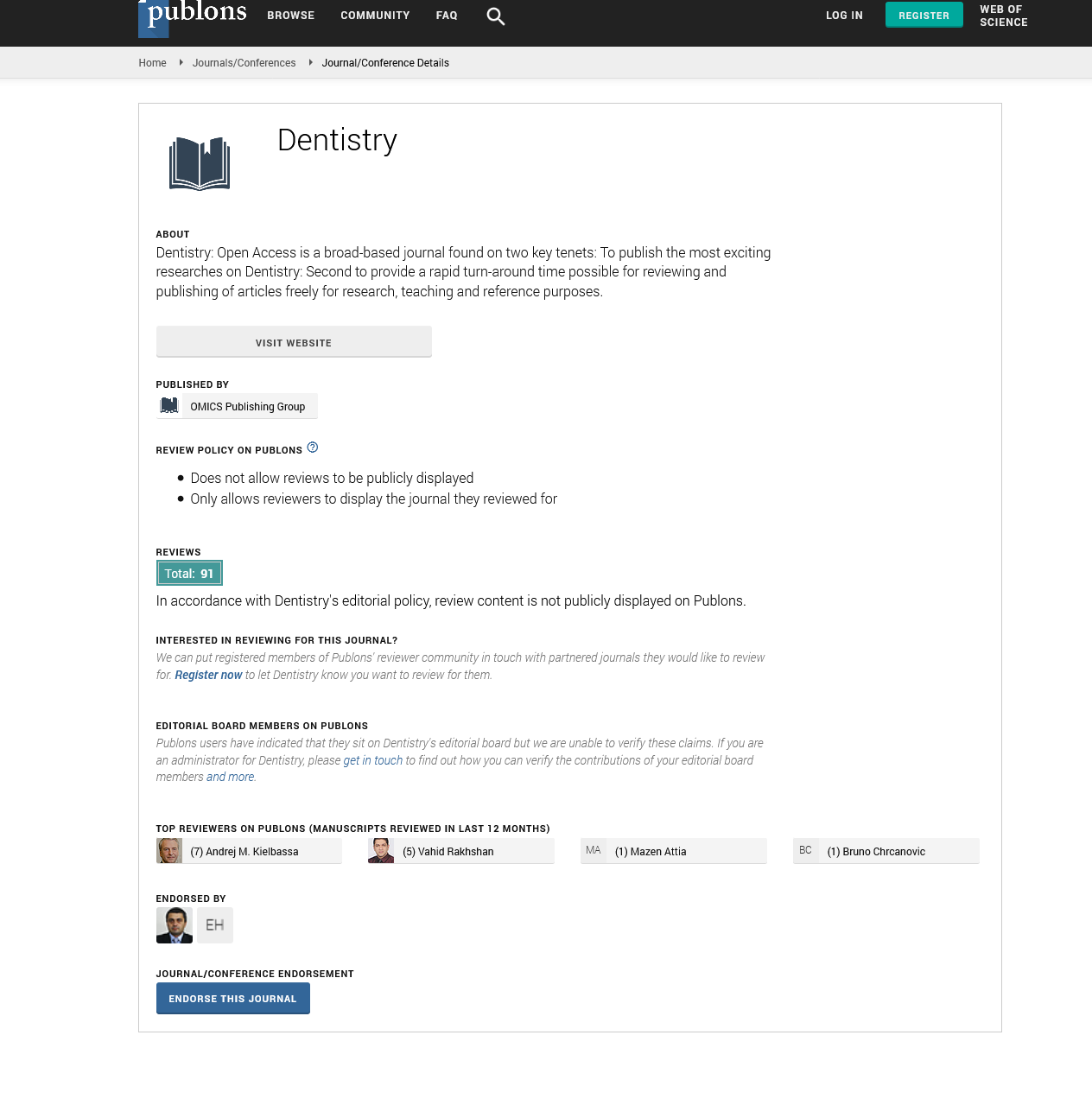Citations : 2345
Dentistry received 2345 citations as per Google Scholar report
Indexed In
- Genamics JournalSeek
- JournalTOCs
- CiteFactor
- Ulrich's Periodicals Directory
- RefSeek
- Hamdard University
- EBSCO A-Z
- Directory of Abstract Indexing for Journals
- OCLC- WorldCat
- Publons
- Geneva Foundation for Medical Education and Research
- Euro Pub
- Google Scholar
Useful Links
Share This Page
Journal Flyer

Open Access Journals
- Agri and Aquaculture
- Biochemistry
- Bioinformatics & Systems Biology
- Business & Management
- Chemistry
- Clinical Sciences
- Engineering
- Food & Nutrition
- General Science
- Genetics & Molecular Biology
- Immunology & Microbiology
- Medical Sciences
- Neuroscience & Psychology
- Nursing & Health Care
- Pharmaceutical Sciences
Commentry - (2022) Volume 12, Issue 1
Role of Forensic Dentistry
Szaleniec Keshavarz*Received: 03-Jan-2022, Manuscript No. DCR-22-587; Editor assigned: 05-Mar-2022, Pre QC No. DCR-22-587; Reviewed: 19-Jan-2022, QC No. DCR-22-587; Revised: 24-Jan-2022, Manuscript No. DCR-22-587; Published: 31-Jan-2022
Description
Forensic dentistry is the processing of examination, and evaluation of dental evidence in criminal proceedings. Forensic dentists assist law enforcement agencies in identifying recovered human bodies, in addition to identifying whole or fragmented bodies. Forensic dentists may also be asked to help determine age, race, profession, previous dental history, and socioeconomic status of the unidentified. Evidence that can be derived from teeth is the age of the child and the identification of the person who owns the tooth. This is done using x-rays, pre-mortem and post-mortem photography, DNA and other dental records.
Another type of evidence is a bite left by the attacker on the victim, by the performer of the victim of the attack, or on an item found at the crime scene. Byte mark analysis has been criticized by several scientific institutions, including the National Academy of Sciences (NAS), the Presidential Science and Technology Advisory Board (PCAST), and the Texas Forensic Commission. There is no scientific research or evidence to support that a bite can have sufficient details for reliable identification. There are many cases where experts have very different ratings for the same byte mark. Forensic dentistry is a study of dental applications in litigation proceedings. Themes cover a variety of topics, including personal identification, mass identification, and byte mark analysis.
The study of dentistry in proceedings can be guilty evidence or an aspect of widespread controversy. Throughout history, there have been many examples where the bite mark has been used as evidence. Bites are usually found in cases of sexual assault, murder, and child abuse and can be an important factor in convictions. Biting is often a sign that the abuser is trying to humiliate the victim and at the same time achieve full control. Bites can be found anywhere on the body. It is especially found in soft, fleshy tissues such as the abdomen and buttocks. In addition, bite marks can be found on objects present at the scene of a crime. Bite marks are commonly found on a suspect when a victim attempts to defend him/herself. The Bureau of Legal Dentistry encourages the use of multiple dental impressions to create a “dental line-up”, similar to a suspect lineup used to identify alleged perpetrators of crime. Currently, dental impressions collected as evidence are compared only to those collected from a given suspect, which may bias the resulting outcome.
Using multiple dental impressions in a line-up may enable forensic odontologist to significantly decrease the current bias in matching bite marks to the teeth of a suspect. The BOLD organization also supports the creation of a database of dental records that may help verify the uniqueness of the dentistry. This database can be created using criminal records or, in some cases, all dental patients. The guidelines are designed to prevent the destruction of potentially useful evidence simply because the forensic dentist's collection method is not standardized. Kouble and Craig used a simplified version of the ABFO scoring guidelines to maintain accuracy across larger samples of comparison. A numerical score was assigned to represent the similarity between the byte mark and the model / coating.
Some characteristics individually evaluated in the ABFO guidelines to simplify the model. The size and shape of the dental arch, which are evaluated together, have such specific characteristics. The distance between teeth was treated as a separate variable. The author believes that the simplified version enhances the strength of the comparison process. IOFOS has developed one of the most recognized systems for forensic evidence collection to improve the dental evidence collection policy.
Citation: Keshavarz S (2022) Role of Forensic Dentistry. J Dentistry. 12:587.
Copyright: © 2022 Keshavarz S. This is an open-access article distributed under the terms of the Creative Commons Attribution License, which permits unrestricted use, distribution, and reproduction in any medium, provided the original author and source are credited.

